韩素音翻译大赛
- 格式:pdf
- 大小:4.98 MB
- 文档页数:20
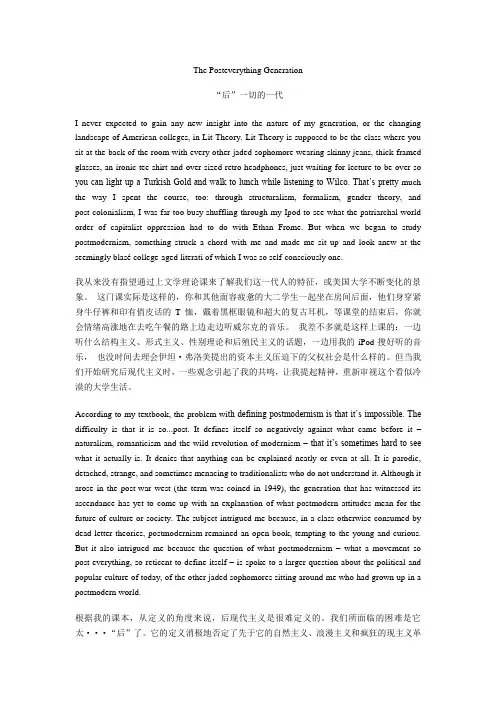
The Posteverything Generation“后”一切的一代I never expected to gain any new insight into the nature of my generation, or the changing landscape of American colleges, in Lit Theory. Lit Theory is supposed to be the class where you sit at the back of the room with every other jaded sophomore wearing skinny jeans, thick-framed glasses, an ironic tee-shirt and over-sized retro headphones, just waiting for lecture to be over so you can light up a Turkish Gold and walk to lunch while listening to Wilco. That’s pretty much the way I spent the course, too: through structuralism, formalism, gender theory, and post-colonialism, I was far too busy shuffling through my Ipod to see what the patriarchal world order of capitalist oppression had to do with Ethan Frome. But when we began to study postmodernism, something struck a chord with me and made me sit up and look anew at the seemingly blasé college-aged literati of which I was so self-consciously one.我从来没有指望通过上文学理论课来了解我们这一代人的特征,或美国大学不断变化的景象。
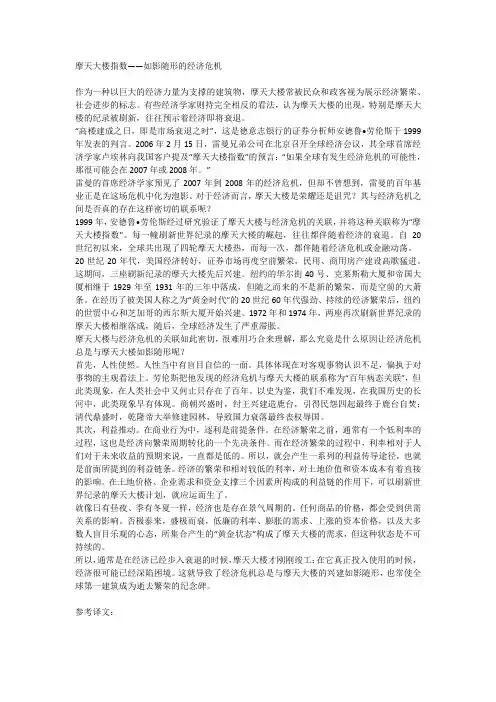
摩天大楼指数——如影随形的经济危机作为一种以巨大的经济力量为支撑的建筑物,摩天大楼常被民众和政客视为展示经济繁荣、社会进步的标志。
有些经济学家则持完全相反的看法,认为摩天大楼的出现,特别是摩天大楼的纪录被刷新,往往预示着经济即将衰退。
“高楼建成之日,即是市场衰退之时”,这是德意志银行的证券分析师安德鲁•劳伦斯于1999年发表的判言。
2006年2月15日,雷曼兄弟公司在北京召开全球经济会议,其全球首席经济学家卢埃林向我国客户提及“摩天大楼指数”的预言:“如果全球有发生经济危机的可能性,那很可能会在2007年或2008年。
”雷曼的首席经济学家预见了2007年到2008年的经济危机,但却不曾想到,雷曼的百年基业正是在这场危机中化为泡影。
对于经济而言,摩天大楼是荣耀还是诅咒?其与经济危机之间是否真的存在这样密切的联系呢?1999年,安德鲁•劳伦斯经过研究验证了摩天大楼与经济危机的关联,并将这种关联称为“摩天大楼指数”。
每一幢刷新世界纪录的摩天大楼的崛起,往往都伴随着经济的衰退。
自20世纪初以来,全球共出现了四轮摩天大楼热,而每一次,都伴随着经济危机或金融动荡。
20世纪20年代,美国经济转好,证券市场再度空前繁荣,民用、商用房产建设高歌猛进。
这期间,三座刷新纪录的摩天大楼先后兴建。
纽约的华尔街40号、克莱斯勒大厦和帝国大厦相继于1929年至1931年的三年中落成,但随之而来的不是新的繁荣,而是空前的大萧条。
在经历了被美国人称之为“黄金时代”的20世纪60年代强劲、持续的经济繁荣后,纽约的世贸中心和芝加哥的西尔斯大厦开始兴建。
1972年和1974年,两座再次刷新世界纪录的摩天大楼相继落成,随后,全球经济发生了严重滞胀。
摩天大楼与经济危机的关联如此密切,很难用巧合来理解,那么究竟是什么原因让经济危机总是与摩天大楼如影随形呢?首先,人性使然。
人性当中有盲目自信的一面。
具体体现在对客观事物认识不足,偏执于对事物的主观看法上。
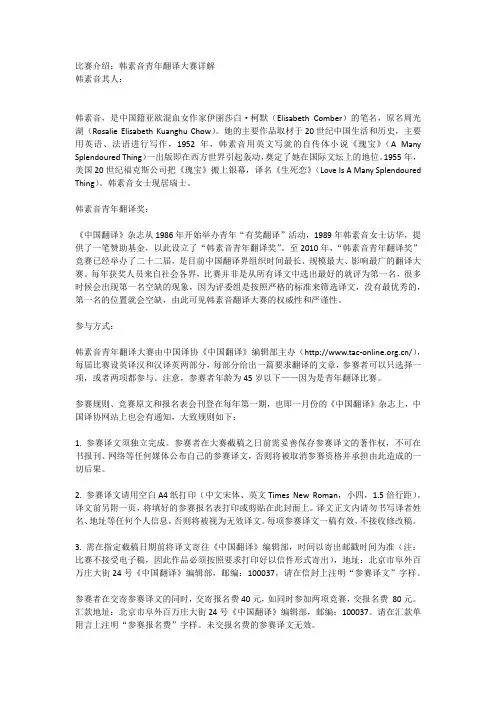
比赛介绍:韩素音青年翻译大赛详解韩素音其人:韩素音,是中国籍亚欧混血女作家伊丽莎白·柯默(Elisabeth Comber)的笔名,原名周光湖(Rosalie Elisabeth Kuanghu Chow)。
她的主要作品取材于20世纪中国生活和历史,主要用英语、法语进行写作,1952年,韩素音用英文写就的自传体小说《瑰宝》(A Many Splendoured Thing)一出版即在西方世界引起轰动,奠定了她在国际文坛上的地位。
1955年,美国20世纪福克斯公司把《瑰宝》搬上银幕,译名《生死恋》(Love Is A Many Splendoured Thing)。
韩素音女士现居瑞士。
韩素音青年翻译奖:《中国翻译》杂志从1986年开始举办青年“有奖翻译”活动,1989年韩素音女士访华,提供了一笔赞助基金,以此设立了“韩素音青年翻译奖”。
至2010年,“韩素音青年翻译奖”竞赛已经举办了二十二届,是目前中国翻译界组织时间最长、规模最大、影响最广的翻译大赛。
每年获奖人员来自社会各界,比赛并非是从所有译文中选出最好的就评为第一名,很多时候会出现第一名空缺的现象,因为评委组是按照严格的标准来筛选译文,没有最优秀的,第一名的位置就会空缺,由此可见韩素音翻译大赛的权威性和严谨性。
参与方式:韩素音青年翻译大赛由中国译协《中国翻译》编辑部主办(/),每届比赛设英译汉和汉译英两部分,每部分给出一篇要求翻译的文章,参赛者可以只选择一项,或者两项都参与。
注意,参赛者年龄为45岁以下——因为是青年翻译比赛。
参赛规则、竞赛原文和报名表会刊登在每年第一期,也即一月份的《中国翻译》杂志上,中国译协网站上也会有通知,大致规则如下:1. 参赛译文须独立完成。
参赛者在大赛截稿之日前需妥善保存参赛译文的著作权,不可在书报刊、网络等任何媒体公布自己的参赛译文,否则将被取消参赛资格并承担由此造成的一切后果。
2. 参赛译文请用空白A4纸打印(中文宋体、英文Times New Roman,小四,1.5倍行距)。
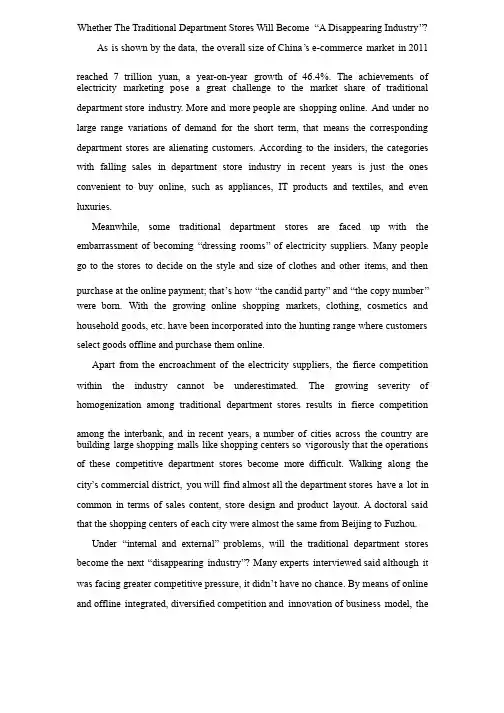
Whether The Traditional Department Stores Will Become “A Disappearing Industry A Disappearing Industry””?As is shown by the data, the overall size of China the overall size of China’’s e-commerce market in 2011 reached 7 trillion yuan, a year-on-year growth of 46.4%. The achievements of electricity marketing pose a great challenge to the market share of traditional department store industry industry. More and . More and more people are shopping online. And under no large range variations of demand for the short term, that means the corresponding department stores are alienating customers. According to the insiders, the categories with falling sales in department store industry in recent years is just the ones convenient to buy online, such as appliances, IT products and textiles, and even luxuries.Meanwhile, some traditional department stores are faced up with the embarrassment of becoming “dressing rooms rooms””of electricity suppliers. Many people go to the stores to decide on the style and size of clothes and other items, and then purchase at the online payment; that purchase at the online payment; that’’s how s how ““the candid party the candid party”” and and ““the copy number the copy number”” were born. With the growing online shopping markets, clothing, cosmetics and household goods, etc. have been incorporated into the hunting range where customers select goods offline and purchase them online.Apart from the encroachment of the electricity suppliers, the fierce competition within the industry cannot be underestimated. The growing severity of homogenization among traditional department stores results in fierce competition among the interbank, and in recent years, a number of cities across the country are building large shopping malls like shopping centers so vigorously that the operations of these competitive department stores become more difficult. Walking along the city city’’s commercial district, you will find almost all the department stores have a lot in common in terms of sales content, store design and product layout. A doctoral said that the shopping centers of each city were almost the same from Beijing to Fuzhou.Under “internal and external external””problems, will the traditional department stores become the next “disappearing industry industry”?”?Many experts interviewed said although it was facing greater competitive pressure, it didn was facing greater competitive pressure, it didn’’t have no chance. By means of online and offline integrated, diversified competition and innovation of business model, thedepartment store industry may achieve the success of “counter-attackcounter-attack””.electronic shock”” are As is informed, the department stores that have experienced “electronic shock minority. . Large department stores in Beijing have built their online not in the minoritye-commerce platforms. The e-commerce in Tianjin Department Store is now under plan of implement.At the same time, department stores should take the path of multi-position management and differentiated marketing, aiming at the targeted customer segments.A doctoral tutor emphasized that in spite of the more severe business environment the department stores had faced in recent years and the more fierce competition among electricity suppliers and large-scale commercial complexes, customer segments of the department stores were just billabong in a part. Department stores should pay more attention to the customer segments they own now, improve after-sale service and explore the personalized service for their customers.In addition, traditional department stores should take advantage of the momentum of development in shopping centers to transform. It It’’s understood that there exist certain corresponding patterns in the structures of the retail industry and per capita GDP. General merchandise stores dominate the market when per capita GDP ranges from $3,000 to $5,000 while shopping centers exclusive shops, specialty stores and convenience stores play a leading role when per capita GDP ranges from $5,000 to $10,000. However, the per capita GDP of our country has risen to more than $5,000 in 2011, so traditional department stores can be directed to the transformation to shopping centers at this time.。
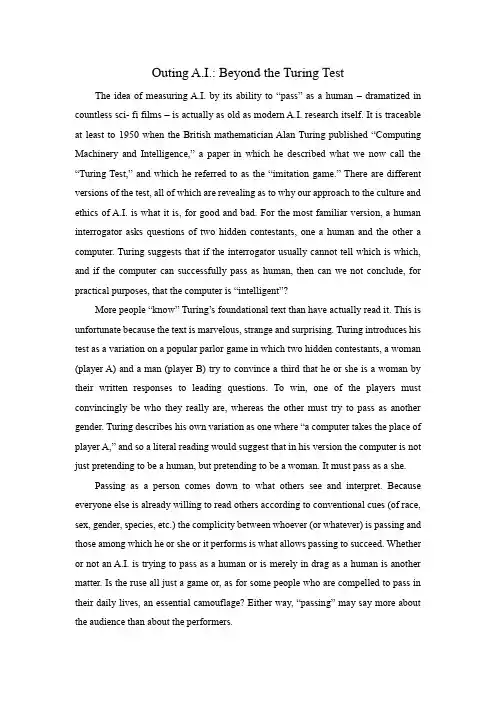
Outing A.I.: Beyond the Turing TestThe idea of measuring A.I. by its ability to “pass” as a human – dramatized in countless sci- fi films – is actually as old as modern A.I. research itself. It is traceable at least to 1950 when the British mathematician Alan Turing published “Computing Machinery and Intelligence,” a paper in which he described what we now call the “Turing Test,” and which he referred to as the “imitation game.” There are different versions of the test, all of which are revealing as to why our approach to the culture and ethics of A.I. is what it is, for good and bad. For the most familiar version, a human interrogator asks questions of two hidden contestants, one a human and the other a computer. Turing suggests that if the interrogator usually cannot tell which is which, and if the computer can successfully pass as human, then can we not conclude, for practical purposes, that the computer is “intelligent”?More people “know” Turing’s foundational text than have actually read it. This is unfortunate because the text is marvelous, strange and surprising. Turing introduces his test as a variation on a popular parlor game in which two hidden contestants, a woman (player A) and a man (player B) try to convince a third that he or she is a woman by their written responses to leading questions. To win, one of the players must convincingly be who they really are, whereas the other must try to pass as another gender. Turing describes his own variation as one where “a computer takes the place of player A,” and so a literal reading would suggest that in his version the computer is not just pretending to be a human, but pretending to be a woman. It must pass as a she.Passing as a person comes down to what others see and interpret. Because everyone else is already willing to read others according to conventional cues (of race, sex, gender, species, etc.) the complicity between whoever (or whatever) is passing and those among which he or she or it performs is what allows passing to succeed. Whether or not an A.I. is trying to pass as a human or is merely in drag as a human is another matter. Is the ruse all just a game or, as for some people who are compelled to pass in their daily lives, an essential camouflage? Either way, “passing” may say more about the audience than about the performers.That we would wish to define the very existence of A.I. in relation to its ability to mimic how humans think that humans think will be looked back upon as a weird sort of speciesism. The legacy of that conceit helped to steer some older A.I. research down disappointingly fruitless paths, hoping to recreate human minds from available parts. It just doesn’t work that way. Contemporary A.I. research suggests instead that the threshold by which any particular arrangement of matter can be said to be “intelligent” doesn’t have much to do with how it reflects humanness back at us. As Stuart Russell and Peter Norvig (now director of research at Google) suggest in their essential A.I. textbook, biomorphic imitation is not how we design complex technology. Airplanes don’t fly like birds fly, and we certainly don’t try to trick birds into thinking that airplanes are birds in order to test whether those planes “really” are flying machines. Why do it for A.I. then? Today’s serious A.I. research does not focus on the Turing Test as an objective criterion of success, and yet in our popular culture of A.I., the test’s anthropocentrism holds such durable conceptual importance. Like the animals who talk like teenagers in a Disney movie, other minds are conceivable mostly by way of puerile ventriloquism.Where is the real injury in this? If we want everyday A.I. to be congenial in a humane sort of way, so what? The answer is that we have much to gain from a more sincere and disenchanted relationship to synthetic intelligences, and much to lose by keeping illusions on life support. Some philosophers write about the possible ethical “rights” of A.I. as sentient entities, but that’s not my point here. Rather, the truer perspective is also the better one for us as thinking technical creatures.Musk, Gates and Hawking made headlines by speaking to the dangers that A.I. may pose. Their points are important, but I fear were largely misunderstood by many readers. Relying on efforts to program A.I. not to “harm humans” (inspired by Isaac Asimov’s “three laws” of robotics from 1942) makes sense only when an A.I. knows what humans are and what harming them might mean. There are many ways that an A.I. might harm us that have nothing to do with its malevolence toward us, and chief among these is exactly following our well-meaning instructions to an idiotic and catastrophic extreme. Instead of mechanical failure or a transgression of moral code, the A.I. maypose an existential risk because it is both powerfully intelligent and disinterested in humans. To the extent that we recognize A.I. by its anthropomorphic qualities, or presume its preoccupation with us, we are vulnerable to those eventualities.Whether or not “hard A.I.” ever appears, the harm is also in the loss of all that we prevent ourselves from discovering and understanding when we insist on protecting beliefs we know to be false. In the 1950 essay, Turing offers several rebuttals to his speculative A.I., including a striking comparison with earlier objections to Copernican astronomy. Copernican traumas that abolish the false centrality and absolute specialness of human thought and species-being are priceless accomplishments. They allow for human culture based on how the world actually is more than on how it appears to us from our limited vantage point. Turing referred to these as “theological objections,” but one could argue that the anthropomorphic precondition for A.I. is a “pre-Copernican” attitude as well, however secular it may appear. The advent of robust inhuman A.I. may let us achieve another disenchantment, one that should enable a more reality-based understanding of ourselves, our situation, and a fuller and more complex understanding of what “intelligence” is and is not. From there we can hopefully make our world with a greater confidence that our models are good approximations of what’s out there.人工智能:超越图灵实验以人工智能“冒充”人的能力的来衡量人工智能的这个概念---已经被数不清的科幻电影搬上了荧幕---实际上已经和现代人工智能研究一样久远了。
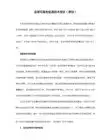
历届韩素音翻译大奖赛竞赛原文及译文英译汉部分 (3)Beauty (excerpt) (3)美(节选) (3)The Literature of Knowledge and the Literature of Power byThomas De Quincey (8)知识文学与力量文学托马斯.昆西 (8)An Experience of Aesthetics by Robert Ginsberg (11)审美的体验罗伯特.金斯伯格 (11)A Person Who Apologizes Has the Moral Ball in His Court by Paul Johnson (14)谁给别人道歉,谁就在道义上掌握了主动保罗.约翰逊 (14)On Going Home by Joan Didion (18)回家琼.狄迪恩 (18)The Making of Ashenden (Excerpt) by Stanley Elkin (22)艾兴登其人(节选)斯坦利.埃尔金 (22)Beyond Life (28)超越生命[美] 卡贝尔著 (28)Envy by Samuel Johnson (33)论嫉妒[英]塞缪尔.约翰逊著 (33)中译英部分 (37)在义与利之外 (37)Beyond Righteousness and Interests (37)读书苦乐杨绛 (40)The Bitter-Sweetness of Reading Yang Jiang (40)想起清华种种王佐良 (43)Reminiscences of Tsinghua Wang Zuoliang (43)歌德之人生启示宗白华 (45)What Goethe's Life Reveals by Zong Baihua (45)怀想那片青草地赵红波 (48)Yearning for That Piece of Green Meadow by Zhao Hongbo (48)可爱的南京 (51)Nanjing the Beloved City (51)霞冰心 (53)The Rosy Cloud byBingxin (53)黎明前的北平 (54)Predawn Peiping (54)老来乐金克木 (55)Delights in Growing Old by Jin Kemu (55)可贵的“他人意识” (58)Calling for an Awareness of Others (58)教孩子相信 (61)To Implant In Our Children’s Young Hearts An Undying Faith In Humanity (61)英译汉部分Beauty (excerpt)美(节选)Judging from the scientists I know, including Eva and Ruth, and those whom I've read about, you can't pursue the laws of nature very long without bumping撞倒; 冲撞into beauty. “I don't know if it's the same beauty you see in the sunset,”a friend tells me, “but it feels the same.”This friend is a physicist, who has spent a long career deciphering破译(密码), 辨认(潦草字迹) what must be happening in the interior of stars. He recalls for me this thrill on grasping for the first time Dirac's⑴equations describing quantum mechanics, or those of Einstein describing relativity. “They're so beautiful,” he says, “you can see immediately they have to be true. Or at least on the way toward truth.” I ask him what makes a theory beautiful, and he replies, “Si mplicity, symmetry .对称(性); 匀称, 整齐, elegance, and power.”我结识一些科学家(包括伊娃和露丝),也拜读过不少科学家的著作,从中我作出推断:人们在探求自然规律的旅途中,须臾便会与美不期而遇。
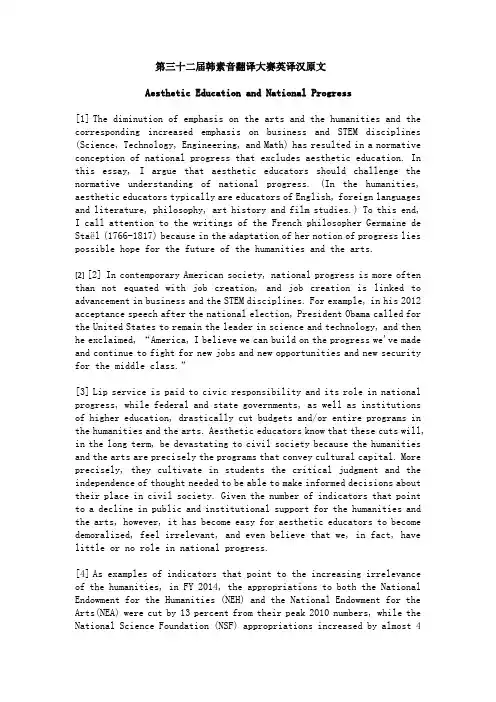
第三十二届韩素音翻译大赛英译汉原文Aesthetic Education and National Progress[1]The diminution of emphasis on the arts and the humanities and the corresponding increased emphasis on business and STEM disciplines (Science, Technology, Engineering, and Math) has resulted in a normative conception of national progress that excludes aesthetic education. In this essay, I argue that aesthetic educators should challenge the normative understanding of national progress. (In the humanities, aesthetic educators typically are educators of English, foreign languages and literature, philosophy, art history and film studies.) To this end, I call attention to the writings of the French philosopher Germaine de Staël (1766-1817) because in the adaptation of her notion of progress lies possible hope for the future of the humanities and the arts.[2][2] In contemporary American society, national progress is more often than not equated with job creation, and job creation is linked to advancement in business and the STEM disciplines. For example, in his 2012 acceptance speech after the national election, President Obama called for the United States to remain the leader in science and technology, and then he exclaimed, “America, I believe we can build on the progress we've made and continue to fight for new jobs and new opportunities and new security for the mi ddle class.”[3]Lip service is paid to civic responsibility and its role in national progress, while federal and state governments, as well as institutions of higher education, drastically cut budgets and/or entire programs in the humanities and the arts. Aesthetic educators know that these cuts will, in the long term, be devastating to civil society because the humanities and the arts are precisely the programs that convey cultural capital. More precisely, they cultivate in students the critical judgment and the independence of thought needed to be able to make informed decisions about their place in civil society. Given the number of indicators that point to a decline in public and institutional support for the humanities and the arts, however, it has become easy for aesthetic educators to become demoralized, feel irrelevant, and even believe that we, in fact, have little or no role in national progress.[4]As examples of indicators that point to the increasing irrelevance of the humanities, in FY 2014, the appropriations to both the National Endowment for the Humanities (NEH) and the National Endowment for the Arts(NEA) were cut by 13 percent from their peak 2010 numbers, while the National Science Foundation (NSF) appropriations increased by almost 4percent from 2010. Perhaps the 13 percent cut would not have been so shocking if the NEH and NEA allocations did not represent a mere 2 percent of the total NSF allocation. The pill is even harder to swallow when one considers that, in 1979, the NEH and the NEA, respectively, received funding equivalent to approximately 16 percent of the NSF.[5]Salaries represent a second measure of the diminishing consideration for the humanities and the arts within university structures. The Oklahoma Faculty Survey by Discipline, a study that surveys the salaries of professors at 114 “Research University/Very High Research Activity” institutions, lists average salaries for all ranks of tenure-track faculty in a number of disciplines. According to the 2013-14 study, the average salary of a faculty member in the arts was $71,463; in English, $76,627; in philosophy and religious studies, $81,971; in physical sciences, $102,636; in engineering, $114,827; and in business management, $139,093. While salaries in 2013-14 increased from 2011-12 in the physical science, engineering, and business management, they decreased in the fine arts, English, and philosophy. If markets drive salaries, the arts and the humanities are clearly not high in market demand. This lack of demand for the humanities and the arts is further underscored in Governor Rick Scott's proposal that tuition rates for Florida state universities be frozen for students who major in “strategic areas”. Lizette Alvarez from the New York Times states of Scott’s proposal, “The messa ge from Tallahassee could not be blunter: Give us engineers, scientists, health care specialists and technology experts. Do not worry so much about historians, philosophers, anthropologists and English majors.” From multiple perspectives, then, we see an explicit shift to STEM disciplines and a discouragement of humanities and arts education, whether in program development, faculty salaries, or student tuitions. Faced with what seems to be such overwhelming confirmation of aesthetic educators’ irrelevance t o today’s understanding of national progress—namely, advancement in business, science and technology—aesthetic educators in the humanities and the arts are struggling to communicate to others outside our field, and to the public at large, our vital role.[6]As demoralizing as the perceived irrelevance of arts and humanities education may be and as disappointing as our attempts to articulate our relevance have been, we may be able to begin to find hope and purpose in renewed debate around how we think about “progress” and, more precisely, the role of aesthetic education in “progress”. The writings of Germaine de Staël are particularly illuminating because they situate aesthetic education squarely in the progress of the nation and have bearing on the dilemma facing the humanities and the arts today. Her prescient philosophy turns the definition of progress on its head and could give aestheticeducators a powerful tool to fight for the increased relevance and vitality of the humanities and the arts in the broader notion of progress.[7]Germaine de Staël’s notion of progress—namely, the alignment of the perfectibility of the human mind (accretion of knowledge) with the perfectibility of the human species (interplay between individual morality and public morality) —has direct bearing on the difficulties that we as aesthetic educators are having today in articulating our essential role in national progress. Obviously, both types of progress (perfectibility of the human mind and perfectibility of the human species) are essential to the progress of the nation, but Germaine de Staël argues convincingly that they must align. Aesthetic educators might thus remind the public that business and the STEM disciplines neither have as their mandate the watchful alignment of individual and public morality (the vector that guarantees freedom and the continual perfecting of the nation) nor do they have as their directive resistance against dogma. Furthermore, investment in STEM at the expense of the arts and the humanities parallels th e Enlightenment’s obsession with progress as defined as the conservation and accretion of empirical knowledge and material gain. This obsession, at least in Germaine de Staël’s view, contributed to the neglect of the interior moral life of the individual. It, furthermore, diminished emphasis on moral responsibility and independence of judgment, which consequently led to increased partisanship, culminating in the fanaticism of the Reign of Terror. While it is hard to imagine the advent of a Reign of Terror in the United States, it can be argued that obsession with unbridled advancement in science and business at the expense of aesthetic education could lead to the weakening of individual morality—defined by Staël as the devotion to freedom, human rights, and the possibility of collective happiness for all.[8] If Germaine de Staël were alive today, she might argue that the solution to our current humanities and arts crisis is a relatively simple one. First, argue for national progress to be understood as the alignment of the perfectibility of the human mind with the perfectibility of the human species. Scientific advancement at the expense of the watchful alignment of individual and public morality poses a threat to the stability of our nation. Consequently, any call for national progress must include sufficient support of and funding for precisely the disciplines (the humanities and the arts) that have this alignment as their mandate. Secondly, encourage educational models that allow for the combination of a “useful” subject that contributes to a knowledge-based economy and a subject in which they will receive an aesthetic education.。
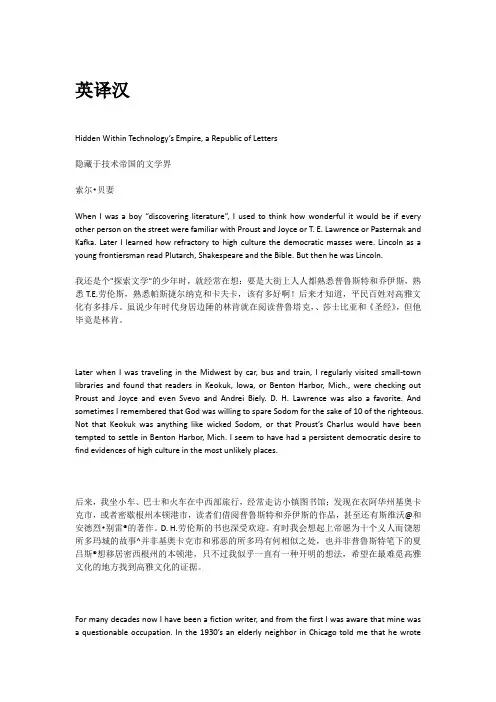
英译汉Hidden Within Technology’s Empire, a Republic of Letters隐藏于技术帝国的文学界索尔•贝妻When I was a boy “discovering literature”, I used to think how wonderful it would be if every other person on the street were familiar with Proust and Joyce or T. E. Lawrence or Pasternak and Kafka. Later I learned how refractory to high culture the democratic masses were. Lincoln as a young frontiersman read Plutarch, Shakespeare and the Bible. But then he was Lincoln.我还是个"探索文学"的少年时,就经常在想:要是大街上人人都熟悉普鲁斯特和乔伊斯,熟悉T.E.劳伦斯,熟悉帕斯捷尔纳克和卡夫卡,该有多好啊!后来才知道,平民百姓对高雅文化有多排斥。
虽说少年时代身居边陲的林肯就在阅读普鲁塔克,、莎士比亚和《圣经》,但他毕竟是林肯。
Later when I was traveling in the Midwest by car, bus and train, I regularly visited small-town libraries and found that readers in Keokuk, Iowa, or Benton Harbor, Mich., were checking out Proust and Joyce and even Svevo and Andrei Biely. D. H. Lawrence was also a favorite. And sometimes I remembered that God was willing to spare Sodom for the sake of 10 of the righteous. Not that Keokuk was anything like wicked Sodom, or that Proust’s Charlus would have been tempted to settle in Benton Harbor, Mich. I seem to have had a persistent democratic desire to find evidences of high culture in the most unlikely places.后来,我坐小车、巴士和火车在中西部旅行,经常走访小镇图书馆;发现在衣阿华州基奥卡克市,或者密歇根州本顿港市,读者们借阅普鲁斯特和乔伊斯的作品,甚至还有斯维沃@和安德烈•别雷®的著作。
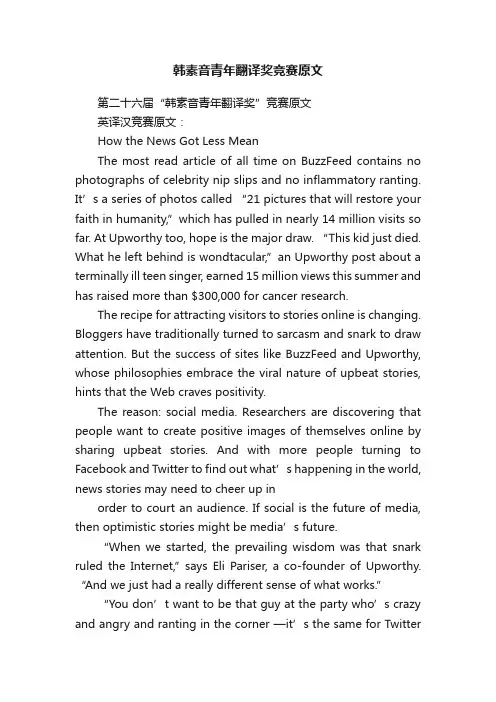
韩素音青年翻译奖竞赛原文第二十六届“韩素音青年翻译奖”竞赛原文英译汉竞赛原文:How the News Got Less MeanThe most read article of all time on BuzzFeed contains no photographs of celebrity nip slips and no inflammatory ranting. It’s a series of photos called “21 pictures that will restore your faith in humanity,”which has pulled in nearly 14 million visits so far. At Upworthy too, hope is the major draw. “This kid just died. What he left behind is wondtacular,”an Upworthy post about a terminally ill teen singer, earned 15 million views this summer and has raised more than $300,000 for cancer research.The recipe for attracting visitors to stories online is changing. Bloggers have traditionally turned to sarcasm and snark to draw attention. But the success of sites like BuzzFeed and Upworthy, whose philosophies embrace the viral nature of upbeat stories, hints that the Web craves positivity.The reason: social media. Researchers are discovering that people want to create positive images of themselves online by sharing upbeat stories. And with more people turning to Facebook and Twitter to find out what’s happening in the world, news stories may need to cheer up inorder to court an audience. If social is the future of media, then optimistic stories might be media’s future.“When we started, the prevailing wisdom was that snark ruled the Internet,”says Eli Pariser, a co-founder of Upworthy. “And we just had a really different sense of what works.”“You don’t want to be that guy at the party who’s crazy and angry and ranting in the corner —it’s the same for Twitteror Facebook,”he says. “Part of what we’re trying to d o with Upworthy is give people the tools to express a conscientious, thoughtful and positive identity in social media.”And the science appears to support Pariser’s philosophy. In a recent study from the Massachusetts Institute of Technology, researchers f ound that “up votes,”showing that a visitor liked a comment or story, begat more up votes on comments on the site, but “down votes”did not do the same. In fact, a single up vote increased the likelihood that someone else would like a comment by 32%, wherea s a down vote had no effect. People don’t want to support the cranky commenter, the critic or the troll. Nor do they want to be that negative personality online.In another study published in 2012, Jonah Berger, author of Contagious: Why Things Catch On and professor of marketing at the Wharton School of the University of Pennsylvania, monitored the most e-mailed stories produced by the New York Times for six months andfound that positive stories were more likely to make the list than negative ones.“What we share [or like] is almost like the car we drive or the clothes we wear,”he says. “It says something about us to other people. So people would much rather be seen as a Positive Polly than a Debbie Downer.”It’s not always that simple: Berger says that th ough positive pieces drew more traffic than negative ones, within the categories of positive and negative stories, those articles that elicited more emotion always led to more shares.“Take two negative emotions, for example: anger and sadness,”Berger says. “Both of those emotions would make the reader feel bad. But anger, a high arousal emotion, leads to moresharing, whereas sadness, a low arousal emotion, doesn’t. The same is true of the positive side: excitement and humor increase sharing, whereas conte ntment decreases sharing.”And while some popular BuzzFeed posts —like the recent “Is this the most embarrassing interview Fox News has ever done?”—might do their best to elicit shares through anger, both BuzzFeed and Upworthy recognize that their main success lies in creating positive viral material.“It’s not that people don’t share negative stories,”says Jack Shepherd, editorial director at BuzzFeed. “It just means that there’s ahigher potential for positive stories to do well.”Upworthy’s mission is to highlight serious issues but in a hopeful way, encouraging readers to donate money, join organizations and take action. The strategy seems to be working: barely two years after its launch date (in March 2012), the site now boasts 30 million unique visitors per month, according to Upworthy. The site’s average monthly unique visitors grew to 14 million people over its first six quarters —to put that in perspective, the Huffington Post had only about 2 million visitors in its first six quarters online.But Upworthy measures the success of a story not just by hits. The creators of the site only consider a post a success if it’s also shared frequently on social media. “We are interested in content that people want to share partly for pragmatic reasons,”Pariser s ays. “If you don’t have a good theory about how to appear in Facebook and Twitter, then you may disappear.”Nobody has mastered the ability to make a story go viral like BuzzFeed. The site, which began in 2006 as a lab to figure out what people share onlin e, has used what it’s learned to draw 60million monthly unique visitors, according to BuzzFeed. (Most of that traffic comes from social-networking sites, driving readers toward BuzzFeed’s mix of cute animal photos and hard news.) By comparison the New York Times website, one of the most popular newspaper sites on the Web,courts only 29 million unique visitors each month, according to the Times.BuzzFeed editors have found that people do still read negative or critical stories, they just aren’t the posts t hey share with their friends. And those shareable posts are the ones that newsrooms increasingly prize.“Anecdotally, I can tell you people are just as likely to click on negative stories as they are to click on positive ones,”says Shepherd. “But they’re m ore likely to share positive stories. What you’re interested in is different from what you want your friends to see what you’re interested in.”So as newsrooms re-evaluate how they can draw readers and elicit more shares on Twitter and Facebook, they may look to BuzzFeed’s and Upworthy’s happiness model for direction.“I think that the Web is only becoming more social,”Shepherd says. “We’re at a point where readers are your publishers. If news sites aren’t thinking about what it would mean for someone to share a story on social media, that could be detrimental.”汉译英竞赛原文:城市的迷失沿着瑗珲—腾冲线,这条1935年由胡焕庸先生发现并命名的中国人口、自然和历史地理的分界线,我们看到,从远距离贸易发展开始的那天起,利益和权力的渗透与分散,已经从根本结构上改变了城市的状态:城市在膨胀,人在疏离。
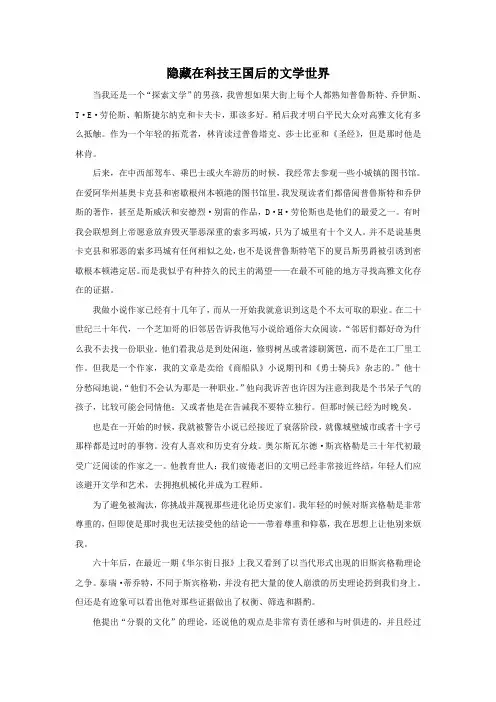
隐藏在科技王国后的文学世界当我还是一个“探索文学”的男孩,我曾想如果大街上每个人都熟知普鲁斯特、乔伊斯、T·E·劳伦斯、帕斯捷尔纳克和卡夫卡,那该多好。
稍后我才明白平民大众对高雅文化有多么抵触。
作为一个年轻的拓荒者,林肯读过普鲁塔克、莎士比亚和《圣经》,但是那时他是林肯。
后来,在中西部驾车、乘巴士或火车游历的时候,我经常去参观一些小城镇的图书馆。
在爱阿华州基奥卡克县和密歇根州本顿港的图书馆里,我发现读者们都借阅普鲁斯特和乔伊斯的著作,甚至是斯威沃和安德烈·别雷的作品,D·H·劳伦斯也是他们的最爱之一。
有时我会联想到上帝愿意放弃毁灭罪恶深重的索多玛城,只为了城里有十个义人。
并不是说基奥卡克县和邪恶的索多玛城有任何相似之处,也不是说普鲁斯特笔下的夏吕斯男爵被引诱到密歇根本顿港定居。
而是我似乎有种持久的民主的渴望——在最不可能的地方寻找高雅文化存在的证据。
我做小说作家已经有十几年了,而从一开始我就意识到这是个不太可取的职业。
在二十世纪三十年代,一个芝加哥的旧邻居告诉我他写小说给通俗大众阅读。
“邻居们都好奇为什么我不去找一份职业。
他们看我总是到处闲逛,修剪树丛或者漆刷篱笆,而不是在工厂里工作。
但我是一个作家,我的文章是卖给《商船队》小说期刊和《勇士骑兵》杂志的。
”他十分愁闷地说,“他们不会认为那是一种职业。
”他向我诉苦也许因为注意到我是个书呆子气的孩子,比较可能会同情他;又或者他是在告诫我不要特立独行。
但那时候已经为时晚矣。
也是在一开始的时候,我就被警告小说已经接近了衰落阶段,就像城壁城市或者十字弓那样都是过时的事物。
没有人喜欢和历史有分歧。
奥尔斯瓦尔德·斯宾格勒是三十年代初最受广泛阅读的作家之一。
他教育世人:我们疲倦老旧的文明已经非常接近终结,年轻人们应该避开文学和艺术,去拥抱机械化并成为工程师。
为了避免被淘汰,你挑战并蔑视那些进化论历史家们。
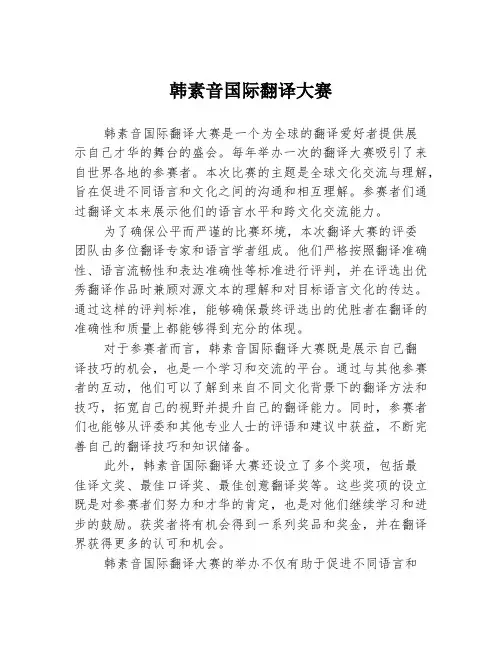
韩素音国际翻译大赛
韩素音国际翻译大赛是一个为全球的翻译爱好者提供展
示自己才华的舞台的盛会。
每年举办一次的翻译大赛吸引了来自世界各地的参赛者。
本次比赛的主题是全球文化交流与理解,旨在促进不同语言和文化之间的沟通和相互理解。
参赛者们通过翻译文本来展示他们的语言水平和跨文化交流能力。
为了确保公平而严谨的比赛环境,本次翻译大赛的评委
团队由多位翻译专家和语言学者组成。
他们严格按照翻译准确性、语言流畅性和表达准确性等标准进行评判,并在评选出优秀翻译作品时兼顾对源文本的理解和对目标语言文化的传达。
通过这样的评判标准,能够确保最终评选出的优胜者在翻译的准确性和质量上都能够得到充分的体现。
对于参赛者而言,韩素音国际翻译大赛既是展示自己翻
译技巧的机会,也是一个学习和交流的平台。
通过与其他参赛者的互动,他们可以了解到来自不同文化背景下的翻译方法和技巧,拓宽自己的视野并提升自己的翻译能力。
同时,参赛者们也能够从评委和其他专业人士的评语和建议中获益,不断完善自己的翻译技巧和知识储备。
此外,韩素音国际翻译大赛还设立了多个奖项,包括最
佳译文奖、最佳口译奖、最佳创意翻译奖等。
这些奖项的设立既是对参赛者们努力和才华的肯定,也是对他们继续学习和进步的鼓励。
获奖者将有机会得到一系列奖品和奖金,并在翻译界获得更多的认可和机会。
韩素音国际翻译大赛的举办不仅有助于促进不同语言和
文化之间的交流和理解,也为翻译专业人士和翻译爱好者提供了一个展示自己才华的平台。
通过这个比赛,我们相信翻译能力和跨文化交流能力将得到更大的关注和重视,为全球文化交流和发展做出更积极的贡献。
保护古村落就是保护“根性文化”To Preserve “Ancient Villages”, to Protect the “Roots of Culture”传统村落是指拥有物质形态和非物质形态文化遗产,具有较高的历史、文化、科学、艺术、社会、经济价值的村落。
但近年来,随着城镇化快速推进,以传统村落为代表的传统文化正在淡化,乃至消失。
对传统村落历史建筑进行保护性抢救,并对传统街巷和周边环境进行整治,可防止传统村落无人化、空心化。
“Traditional villages” refer to those with tangible and intangible cultural heritages and of high historic, cultural, scientific, artistic, social and economic value. But in recent years, traditional cultures represented by traditional villages have been fading away or even dying out with rapid urbanization. In order to prevent those villages from being uninhabited or hollowed out, we must protect historic buildings at risk there, restore the old streets and lanes, and renovate their surroundings.古村落与其说是老建筑,倒不如说是一座座承载了历史变迁的活建筑文化遗产,任凭世事变迁,斗转星移,古村落依然岿然不动,用无比顽强的生命力向人们诉说着村落的沧桑变迁,尽管曾经酷暑寒冬,风雪雨霜,但是古老的身躯依然支撑着生命的张力,和生生不息的人并肩生存,从这点上说,沧桑的古村落也是一种无形的精神安慰。
第十二届“韩素音青年翻译奖”竞赛原文及参考译文(汉译英)霞冰心四十年代初期,我在重庆郊外歌乐山闲居的时候,曾看到英文《读者文摘》上,有个很使我惊心的句子,是:May there be enough clouds in your life to make a beautiful sunset.我在一篇短文里曾把它译成:“愿你的生命中有够多的云翳,来造成一个美丽的黄昏。
”其实,这个sunset 应当译成“落照”或“落霞”。
霞,是我的老朋友了!我童年在海边、在山上,她都是我的最熟悉最美丽的小伙伴。
她每早每晚都在光明中和我说“早上好”或“明天见”。
但我直到几十年以后,才体会到云彩更多,霞光才愈美丽。
从云翳中外露的霞光,才是璀璨多彩的。
生命中不是只有快乐,也不是只有痛苦,快乐和痛苦是相生相成,互相衬托的。
快乐是一抹微云,痛苦是压城的乌云,这不同的云彩,在你生命的天边重叠着,在“夕阳无限好”的时候,就给你造成一个美丽的黄昏。
一个生命会到了“只是近黄昏”的时节,落霞也许会使人留恋、惆怅。
但人类的生命是永不止息的。
地球不停地绕着太阳自转。
东方不亮西方亮,我床前的晚霞,正向美国东岸的慰冰湖上走去……The Rosy CloudBingxinDuring the early 1940s I was living a retired life in the Gele Mountains in the suburbs of Chongqing (Chungking). One day, while reading the English language magazine Reader's Digest I found a sentence that touched me greatly. It read: "May there be enough clouds in your life to make a beautiful sunset."In a short article of mine, I quoted this sentence and translated it as "Yuan ni de shengming zhong you guo duo de yunyi, lai zaocheng yige meili de huanghun. " (literally: May there be enough clouds in your life to make a beautiful sunset.) *As I see it now, the word "sunset" in the English sentence should have been translated as luozhao (the glow at sunset) or luoxia (the rosy cloud at sunset), instead of dusk.She has been my dear old friend, the Rosy Cloud! She was my closest and most beautiful little companion when, in my childhood, I played on the beach or in the hills. Bathed in the brilliant sunshine, she would say to me "Good morning!" at dawn and "See you tomorrow!" at dusk. But not until several decades later did I come to realize that the more clouds there are the more beautiful the rays of sunlight will be, and the glow of the sun breaking through the clouds becomes most resplendent and colorful.Life contains neither unalloyed happiness nor mere misery. Happiness and misery beget, complement and set off each other.Happiness is a wisp of fleecy cloud; misery a mass of threatening dark cloud. These different clouds overlap on the horizon of your life to create a beautiful dusk for you when "the setting sun is most lovely indeed."**An individual's life must inevitably reach the point when "dusk is so near,"*** and the rosy sunset cloud may make one nostalgic and melancholy. But human life goes on and on. The Earth ceaselessly rotates on its axis around the sun. When it is dark in the east, it is light in the west. The rosy sunset cloud is now sailing past my window towards Lake Waban on the east coast of America ...*This sentence appears in Chinese and English in the article "For Young Readers Again, Newsletter No.4", written by Bing Xin in the Gele Mountains, on December 1, 1944.** and *** These two poetic lines are taken from a poem "On the Plain of Tombs" by Li Shangyin (813-858), a well-known poet of the Tang Dynasty (618-907). The two lines read like this: "The setting sun appears sublime, / But O! 'Tis near its dying time." (Tr. Xu Yuanchong) They imply that the setting sun has infinite beauty, but it is a pity that it is near the dusk, and the beautiful scene cannot last long. The two lines are often used to deplore the ephemeral nature of things, and to express the feelings at the loss of past glory and at the advent of old age.。
评第十三届“韩素音青年翻译奖”英译汉参考译文朱志瑜(香港理工大学中文及双语系)近年中国翻译研究发展很快,但翻译批评始终落后。
理论界早就注意到了这一点,但到目前为止,对翻译批评却还是说得多做得少。
其中原因是多方面的。
要批评就要将原文、译文从头至尾或者至少将重要章节对照一遍,费时费力;批评写出来,可能牵涉到译者和译文出版者的利益(如译者声誉、译文销量等),学报是否支持发表,译文出版者是否欢迎──几年前听说过译文出版者打电话给学报编辑阻止评论发表的事情──这些都是在撰写批评之前需要慎重考虑的,否则费力不讨好,说得严重点,可能影响到评者的人际关系以至声誉。
这本不是健康学术的表现,但在中国这个大的学术环境之下,批评始终难以开展确实是个事实。
翻译批评的落后不但是中国翻译学科不成熟的反映,而且还会阻碍学科的发展。
本文仅就第十三届“韩素音青年翻译奖”英译汉“参考译文”(以下简称“译文”)和评者在“译文评析”(简称“评析”)中对参赛译文的评述提出一些看法,也算是一种翻译批评,希望对青年翻译家、学者能有所帮助。
两篇文章都载于《中国翻译》2001年第一期。
今年十月在广州开会的时候,我也顺便征求了广外部分参与奖项评议的同事的意见,回来又做了些修改,写成了这篇文章。
我首先要指出的是,“译文”经过认真的研究、讨论,是了一篇相当优秀的译文;“评析”也指出了一些粗心的译者常犯的错误和应该注意的问题。
“译文”和“评析”虽然有值得讨论的地方,但瑕不掩瑜,这恰恰说明了“译无止境”这个道理。
我这里只是抱着精益求精、共同提高的态度,对评委的“评析”和“译文”提出一些意见。
还有一点要指出的是,没有不犯错误的翻译家;尤其是比赛参考译文,一旦刊出,几万只眼睛挑毛病,实在不容易讨好;但是指出别人的翻译错误却是很容易的一件事情。
原文是一篇散文,属于文学类型。
根据功能主义的原则,原文为“表情类”(expressive)。
“评析”提出的“字斟句酌、形义并重”的原则,是正确的翻译策略,即译文不仅要表达原文的内容,而且要反映原文为了表达这个内容所使用的修辞、句法等手段。
Aesthetic Education and National Progress[1] The diminution of emphasis on the arts and the humanities and the corresponding increased emphasis on business and STEM disciplines (Science, Technology, Engineering, and Math) has resulted in a normative conception of national progress that excludes aesthetic education. In this essay, I argue that aesthetic educators should challenge the normative understanding of national progress. (In the humanities, aesthetic educators typically are educators of English, foreign languages and literature, philosophy, art history and film studies.) To this end, I call attention to the writings of the French philosopher Germaine de Staël (1766-1817) because in the adaptation of her notion of progress lies possible hope for the future of the humanities and the arts.[2] In contemporary American society, national progress is more often than not equated with job creation, and job creation is linked to advancement in business and the STEM disciplines. For example, in his 2012 acceptance speech after the national election, President Obama called for the United States to remain the leader in science and technology, and then he exclaimed, “America, I believe we can build on the progress we've made and continue to fight for new jobs and new opportunities and new security for the middle class.”[3] Lip service is paid to civic responsibility and its role in national progress, while federal and state governments, as well as institutions of higher education, drastically cut budgets and/or entire programs in the humanities and the arts. Aesthetic educators know that these cuts will, in the long term, be devastating to civil society because the humanities and the arts are precisely the programs that convey cultural capital. More precisely, they cultivate in students the critical judgment and the independence of thought needed to be able to make informed decisions about their place in civil society. Given the number of indicators that point to a decline in public and institutional support for the humanities and the arts, however, it has become easy for aesthetic educators to become demoralized, feel irrelevant, and even believe that we, in fact, have little or no role in national progress.[4] As examples of indicators that point to the increasing irrelevance of the humanities, in FY 2014, the appropriations to both the National Endowment for the Humanities (NEH) and the National Endowment for the Arts(NEA) were cut by 13 percent from their peak 2010 numbers, while the National Science Foundation (NSF) appropriations increased by almost 4 percent from 2010. Perhaps the 13 percent cut would not have been so shocking if the NEH and NEA allocations did not represent a mere 2 percent of the total NSF allocation. The pill is even harder to swallow when one considers that, in 1979, the NEH and the NEA, respectively, received funding equivalent to approximately 16 percent of the NSF.[5] Salaries represent a second measure of the diminishing consideration for the humanities and the arts within university structures. The Oklahoma Faculty Survey by Discipline, a study that surveys the salaries of professors at 114 “Research University/Very High Research Activity”institutions, lists average salaries for all ranks of tenure-track faculty in a number of disciplines. According to the 2013-14 study, the average salary of a faculty member in the arts was $71,463; in English, $76,627; in philosophy and religious studies, $81,971; in physical sciences, $102,636; in engineering, $114,827; and in business management, $139,093. While salaries in 2013-14 increased from 2011-12 in the physical science, engineering, and business management, they decreased in the fine arts, English, and philosophy. If markets drive salaries, the arts and the humanities are clearly not high in market demand. This lack of demand for the humanities and the arts is further underscored in Governor Rick Scott's proposal that tuition rates for Florida state universities be frozen for students who major in “strategic areas”. Lizette Alvarez from the New York Times states of Scott’s proposal, “The message from Tallahassee could not be blunter: Give us engineers, scientists, health care specialists and technology experts. Do not worry so much about historians, philosophers, anthropologists and English majors.”From multiple perspectives, then, we see an explicit shift to STEM disciplines and a discouragement of humanities and arts education, whether in program development, faculty salaries, or student tuitions. Faced with what seems to be such overwhelming confirmation of aesthetic educators’ irrelevance to today’s understanding of national progress—namely, advancement in business, science and technology—aesthetic educators in the humanities and the arts are struggling to communicate to others outside our field, and to the public at large, our vital role.[6] As demoralizing as the perceived irrelevance of arts and humanities education may be and as disappointing as our attempts to articulate our relevance have been, we may be able to begin to find hope and purpose in renewed debate around how we think about “progress”and, more precisely, the role of aesthetic education in “progress”. The writings of Germaine de Staël are particularly illuminating because they situate aesthetic education squarely in the progress of the nation and have bearing on the dilemma facing the humanities and the arts today. Her prescient philosophy turns the definition of progress on its head and could give aesthetic educators a powerful tool to fight for the increased relevance and vitality of the humanities and the arts in the broader notion of progress.[7] Germaine de Staël’s notion of progress—namely, the alignment of the perfectibility of the human mind (accretion of knowledge) with the perfectibility of the human species (interplay between individual morality and public morality) —has direct bearing on the difficulties that we as aesthetic educators are having today in articulating our essential role in national progress. Obviously, both types of progress (perfectibility of the human mind and perfectibility of the human species) are essential to the progress of the nation, but Germaine de Staël argues convincingly that they must align. Aesthetic educators might thus remind the public that business and the STEM disciplines neither have as their mandate the watchful alignment of individual and public morality (the vector that guarantees freedom and the continual perfectingof the nation) nor do they have as their directive resistance against dogma. Furthermore, investment in STEM at the expense of the arts and the humanities parallels the Enlightenment’s obsession with progress as defined as the conservation and accretion of empirical knowledge and material gain. This obsession, at least in Germaine de Staël’s view, contributed to the neglect of the interior moral life of the individual. It, furthermore, diminished emphasis on moral responsibility and independence of judgment, which consequently led to increased partisanship, culminating in the fanaticism of the Reign of Terror. While it is hard to imagine the advent of a Reign of Terror in the United States, it can be argued that obsession with unbridled advancement in science and business at the expense of aesthetic education could lead to the weakening of individual morality—defined by Staël as the devotion to freedom, human rights, and the possibility of collective happiness for all.[8] If Germaine de Staël were alive today, she might argue that the solution to our current humanities and arts crisis is a relatively simple one. First, argue for national progress to be understood as the alignment of the perfectibility of the human mind with the perfectibility of the human species. Scientific advancement at the expense of the watchful alignment of individual and public morality poses a threat to the stability of our nation. Consequently, any call for national progress must include sufficient support of and funding for precisely the disciplines (the humanities and the arts) that have this alignment as their mandate. Secondly, encourage educational models that allow for the combination of a “useful”subject that contributes to a knowledge-based economy and a subject in which they will receive an aesthetic education.。
第三十二届韩素音国际翻译大赛英译汉翻译报告摘要:本次翻译的源文本为韩素音翻译大赛的英译汉竞赛原文,英文字数一千多字。
在翻译的过程中,运用到了一些翻译技巧,且遇到了一些困难,通过反复的修正得以解决。
本文将通过文中的一些翻译例子来分析在本次翻译过程中所用到的翻译技巧和遇到的困难点。
关键词:英译汉,翻译技巧,困难点1.引言著名作家于冠西说:“人类文化从整体来说,是各国、各民族的文化汇聚、交流的产物。
”不同文化的交流必须通过翻译来完成,没有翻译就没有文化交流。
翻译不仅是不同语言相互转换的过程,更是不同文化相互融合的过程。
不同国家和民族的不同环境氛围,独特思维方法、价值观念、风俗习惯,造就了不同文化的独特内涵和文化特色,呈现出明显的差异。
这种差异阻碍了信息的交流和沟通,给翻译带来一定阻碍和困难。
因此,如何成功解决这些困难,寻求恰当翻译技巧,在整个翻译过程中至关重要。
1.翻译过程分析翻译的源文本为英文,所以翻译的前提是先理解原文,在对原文有了深刻透彻的理解的基础上才能组织中文语言进行表达。
目标读者为中国人,所以译文既要忠实于原文,又要符合汉语的表达习惯。
翻译最重要的是传递信息,所以译文首先是达意,在达意的基础上注意形式的对应。
并且翻译不可太晦涩生硬,要适当地运用一定的翻译技巧来使译文流畅通顺。
而在翻译的过程中,通常要运用到多种翻译技巧,下面运用实例来介绍一下在翻译“Aesthetic Education and National Progress”这篇文章的过程中所用到的翻译技巧。
2.1翻译技巧例1:原文:I argue that aesthetic educators should challenge the normative understanding of national progress.译文:我认为,美学教育者应该调整对国家进步的既定认识。
本句中,“challenge”直译的话是“挑战”,“ normative understanding”直译是“规范性认识”。